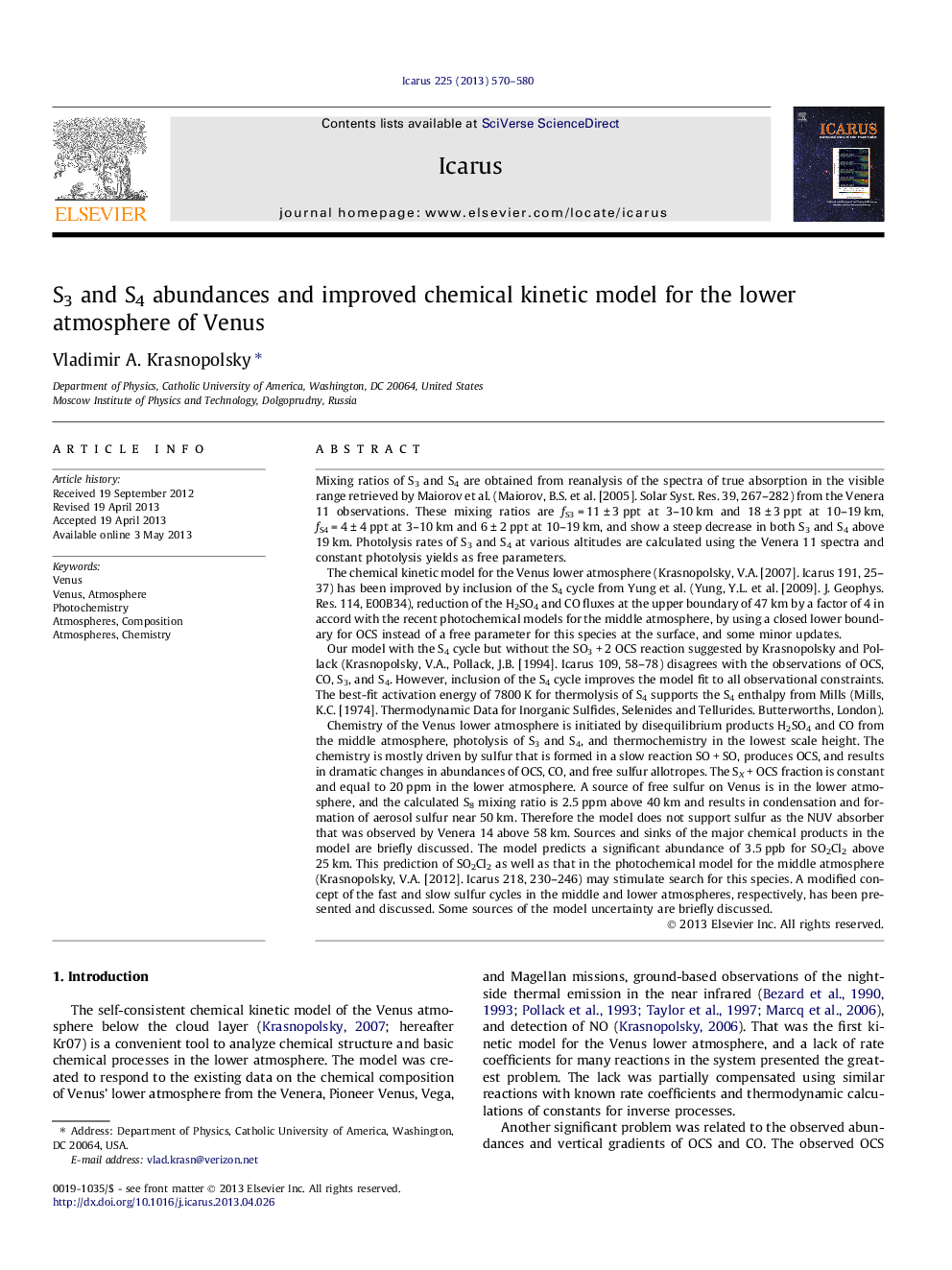| کد مقاله | کد نشریه | سال انتشار | مقاله انگلیسی | نسخه تمام متن |
|---|---|---|---|---|
| 1773228 | 1021122 | 2013 | 11 صفحه PDF | دانلود رایگان |

• Retrieved S3 and S4 abundances in the lower atmosphere of Venus from the Venera 11 spectra.
• The S4 cycle is tested: it cannot explain the observed OCS and CO but helps to fit the observations of S3 and S4.
• Improved chemical kinetic model for the lower atmosphere of Venus agree with all observational constraints.
• The model predicts 3.5 ppb of SO2Cl2 on Venus.
Mixing ratios of S3 and S4 are obtained from reanalysis of the spectra of true absorption in the visible range retrieved by Maiorov et al. (Maiorov, B.S. et al. [2005]. Solar Syst. Res. 39, 267–282) from the Venera 11 observations. These mixing ratios are fS3 = 11 ± 3 ppt at 3–10 km and 18 ± 3 ppt at 10–19 km, fS4 = 4 ± 4 ppt at 3–10 km and 6 ± 2 ppt at 10–19 km, and show a steep decrease in both S3 and S4 above 19 km. Photolysis rates of S3 and S4 at various altitudes are calculated using the Venera 11 spectra and constant photolysis yields as free parameters.The chemical kinetic model for the Venus lower atmosphere (Krasnopolsky, V.A. [2007]. Icarus 191, 25–37) has been improved by inclusion of the S4 cycle from Yung et al. (Yung, Y.L. et al. [2009]. J. Geophys. Res. 114, E00B34), reduction of the H2SO4 and CO fluxes at the upper boundary of 47 km by a factor of 4 in accord with the recent photochemical models for the middle atmosphere, by using a closed lower boundary for OCS instead of a free parameter for this species at the surface, and some minor updates.Our model with the S4 cycle but without the SO3 + 2 OCS reaction suggested by Krasnopolsky and Pollack (Krasnopolsky, V.A., Pollack, J.B. [1994]. Icarus 109, 58–78) disagrees with the observations of OCS, CO, S3, and S4. However, inclusion of the S4 cycle improves the model fit to all observational constraints. The best-fit activation energy of 7800 K for thermolysis of S4 supports the S4 enthalpy from Mills (Mills, K.C. [1974]. Thermodynamic Data for Inorganic Sulfides, Selenides and Tellurides. Butterworths, London).Chemistry of the Venus lower atmosphere is initiated by disequilibrium products H2SO4 and CO from the middle atmosphere, photolysis of S3 and S4, and thermochemistry in the lowest scale height. The chemistry is mostly driven by sulfur that is formed in a slow reaction SO + SO, produces OCS, and results in dramatic changes in abundances of OCS, CO, and free sulfur allotropes. The SX + OCS fraction is constant and equal to 20 ppm in the lower atmosphere. A source of free sulfur on Venus is in the lower atmosphere, and the calculated S8 mixing ratio is 2.5 ppm above 40 km and results in condensation and formation of aerosol sulfur near 50 km. Therefore the model does not support sulfur as the NUV absorber that was observed by Venera 14 above 58 km. Sources and sinks of the major chemical products in the model are briefly discussed. The model predicts a significant abundance of 3.5 ppb for SO2Cl2 above 25 km. This prediction of SO2Cl2 as well as that in the photochemical model for the middle atmosphere (Krasnopolsky, V.A. [2012]. Icarus 218, 230–246) may stimulate search for this species. A modified concept of the fast and slow sulfur cycles in the middle and lower atmospheres, respectively, has been presented and discussed. Some sources of the model uncertainty are briefly discussed.
Journal: Icarus - Volume 225, Issue 1, July 2013, Pages 570–580